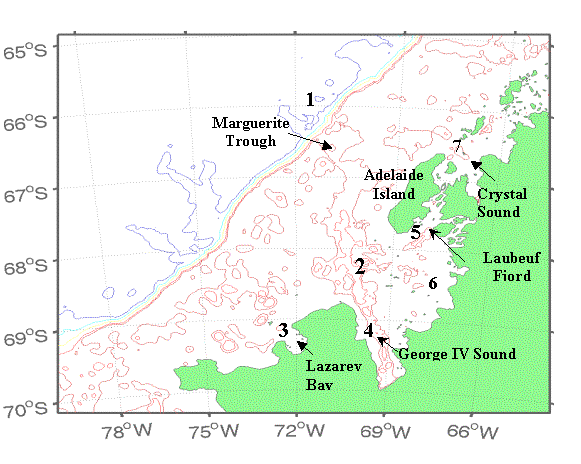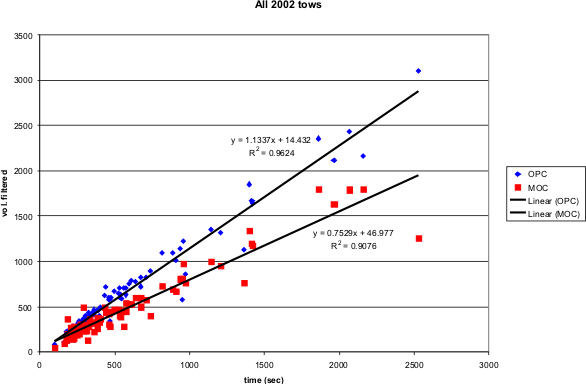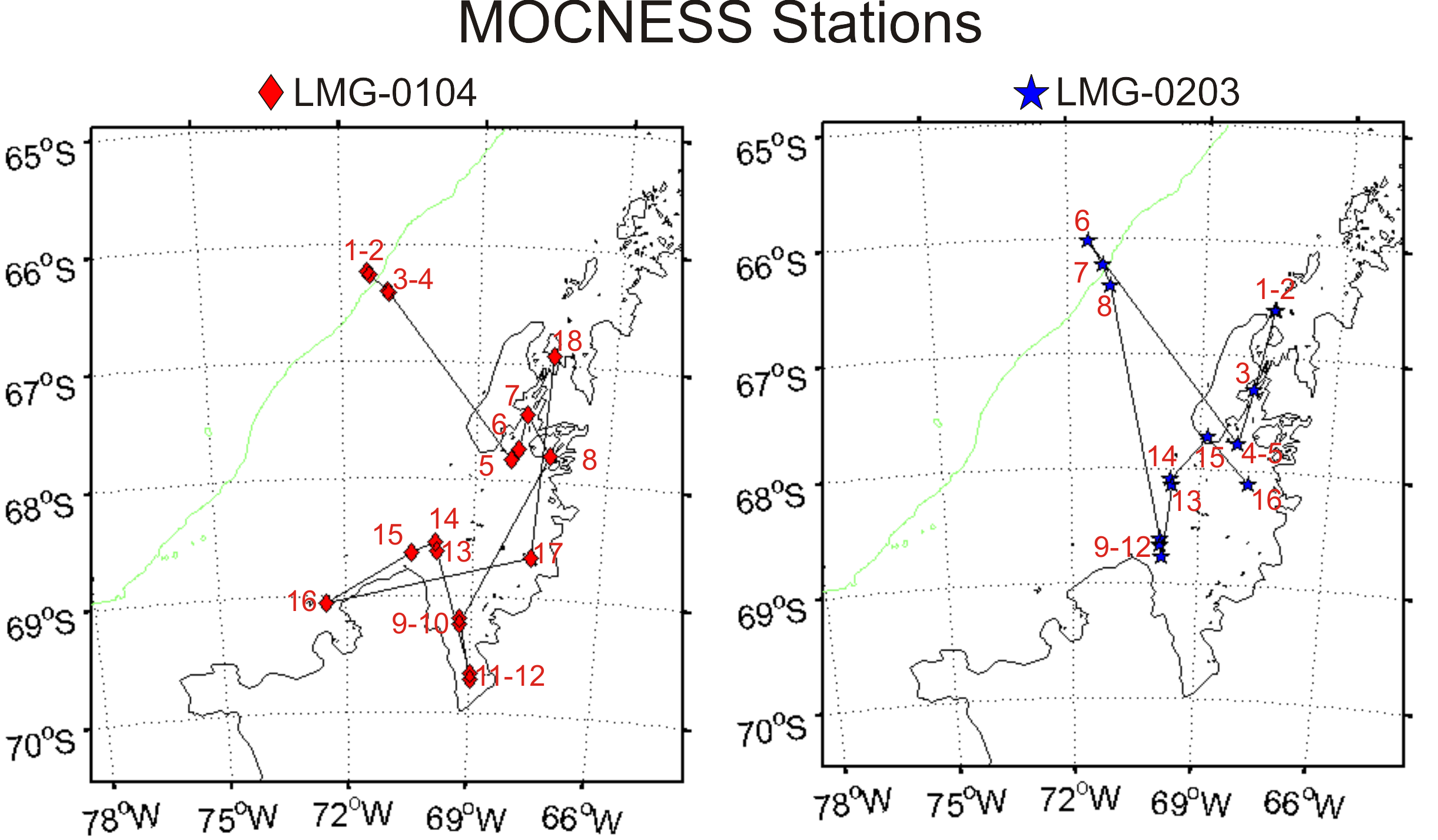Zooplankton abundance with developmental stages from MOCNESS nets from the ARSV Laurence M. Gould LMG0104, LMG0203 from the Southern Ocean, 2001-2002 (SOGLOBEC project)
Project
Program
| Contributors | Affiliation | Role |
|---|---|---|
| Daly, Kendra L. | University of South Florida (USF) | Principal Investigator |
| Copley, Nancy | Woods Hole Oceanographic Institution (WHOI BCO-DMO) | BCO-DMO Data Manager |
Abstract
Zooplankton Abundance Based on Taxa and Life Stages or Size Collected during the Process Cruises, Austral Autumn 2001 and 2002
Data Contributed By:
Kendra L. Daly
College of Marine Science
University of South Florida
140 Seventh Ave. S.
St. Petersburg, FL 33701
Phone: 727-553-1041
E-Mail: kdaly@marine.usf.edu
Net sample collections by: Meng Zhou, Yiwu Zhu, Ryan Dorland, Dan Mertes, and Joe Smith
Sample Analyses by: Jason Zimmerman, Alexander Timonin, Tatjana Semenova
Zooplankton abundance, vertical and horizontal distribution, and population structure were assessed using a 1 m2 Multiple Opening and Closing Nets and Environmental Sampling System (MOCNESS) with nine nets having 333um mesh and environmental sensors of temperature, salinity, and depth. The entire water column was sampled on the downcast using net # 0, which was not analyzed. The upper water column was typically sampled using nets 1 and 2 from 500 m to 200 m at 150 m depth intervals, nets 3 and 4 from 200 m to 100 m at 50 m depth intervals, and nets 5 to 8 from 100 m to the surface at 25 m depth intervals. Some tows were deployed down to 1000 m, and some tows were towed targeting krill swarms at irregular depths. Approximate locations of process study stations are shown in Fig. 1. More precise locations of the casts in Fig. 2.

Fig. 1. Approximate locations of process cruise stations in Marguerite Bay during austral autumn 2001 and 2002.
Fig. 2. Locations of MOCNESS stations for LMGould-0104 (2001) and LMGould-0203 (2002) cruises. Numbers correspond to the cast number.
Zooplankton samples were immediately preserved in 10% buffered formalin solution. All the large organisms (>15 mm) in the sample were removed and identified to taxa. The sample was then split to about 100 individuals of euphausiids. All euphausiids in the split were identified to species and life history stage and measured for length to the nearest 0.5 mm for larvae and to the nearest 1.0 mm for juvenile and adults. Next the sample was split to about 100 individuals of copepods. Copepods were identified to species and life history stage (female, male, copepodite V, or other copepodite). All other zooplankton in the split were identified to taxa and counted. For the Euchaetidae, we followed the designation of Park (1994) who ascribed the Antarctic species to the genus Paraeuchaeta. This data object ("krill") reports the abundance of each euphausiid species by life stage and size class. The companion data object "zooabund" reports the counts of zooplankton per subsample/split by taxa and life stage or size class.
Greenwich Mean Time was local time + 4 hours.
Notes on Volume Filtered values:
The 1 m2 MOCNESS net volume filtered data were corrected for the following net tows:
The flowmeter used to calculate the volume of water filtered did not work for the tows shown below; the data shown in the listings for those tows are therefore derived, not measured. Using the net distance and the average angle of the net, the volume filtered was estimated. These estimates have about a 10% error or higher when currents were present.
2001. No further corrections. MOC-1 net volume filtered values were used to calculate abundance/m3 for all net tows. No Optical Plankton Counter (OPC) volume filtered values were available for 2001.
2002. The flowmeter data was not accurate for some net tows in 2002. Optical Plankton Counter (OPC) volume filtered was used to calculate abundance/m3 for all MOC-1 net tows, except casts 11 and 16 which used the MOC-1 volume filtered values. The decision to use OPC values was determined by plotting all OPC volume filtered numbers versus MOC-1 flow meter data (see below). MOC-1 flow meter data were consistently lower and had a lower R2 regression for volume filtered versus length of tow (time). Meng Zhou and Yiwi Zhu, who conducted the MOC-1 net tows, noted on the haul sheets that there were problems with the MOC-1 flow meters and that they often were not responsive or worked intermittently. Thus, it was decided that the OPC flow meter data provided a more consistent measure of net flow volume for 2002 net tows. The OPC mouth opening for flow meter data was corrected to the MOC-1 net mouth opening by multiplying the OPC flow data by 200. The two casts that used MOC-1 flow meter data were cases where the OPC flow meter data appeared to underestimate the flow.

Fig. 3. Volume filtered over time for both MOCNESS and Optical Plankton Counter showing consistently lower flow rates for the MOCNESS.
Notes on missing samples:
LMG0104 - Station 1A, tow 1, net 2: non-quantitative sample
LMG0104 - Station 1A, tow 1, net 8: no sample
| File |
|---|
zooabund_lmg.csv (Comma Separated Values (.csv), 3.05 MB) MD5:70f4b72b30aee401d3da4bbf3959feca Primary data file for dataset ID 2386 |
| Parameter | Description | Units |
| cruiseid | Cruise identifier (LMG0104, LMG0203) | |
| station | Station number | |
| month_local | Month of year, local time | |
| day_local | Day of month, local time | |
| event | Event number from cruise event log; unique ID | |
| lat | Latitude at beginning of net tow, negative = South | decimal degrees |
| lon | Longitude at beginning of net tow, negative = West | decimal degrees |
| net | Net number (1-8) | |
| vol_filt | Volume of water filtered by net | cubic meters |
| displ_vol | Displacement volume | cubic centimeters |
| depth_open | Depth each net was opened | meters |
| depth_close | Depth each net was closed | meters |
| taxon | Scientific name of organism or common name of group | |
| stage | Life history stage, e.g.: | |
| samp_fraction_denom | The subsample split fraction, expressed as the denominator of the given fraction (i.e. 1/16 = 16, 1/400 = 400), a flag value of 6.6667 represents the fraction 3/20 (20/3 = 6.6667) | |
| cast | Net tow number | |
| abundance | Number of individuals per cubic meter | number/m^3 |
| count | Number of individuals counted in sample or sample fraction | |
| taxon_group | Taxonomic group, usually a mixture of classifications. e.g. copepoda, euphausiacea, other zooplankton | |
| time_start_local | starting time of observation, local time , 24 hour clock | HHmm |
| year | Year of sampling | unitless |
| comments | Comments | unitless |
| Dataset-specific Instrument Name | MOCNESS1 |
| Generic Instrument Name | MOCNESS1 |
| Dataset-specific Description | Zooplankton abundance, vertical and horizontal distribution, and population structure were assessed using a 1 m2 Multiple Opening and Closing Nets and Environmental Sampling System (MOCNESS) with nine nets having 333 µm mesh and environmental sensors of temperature, salinity and depth. |
| Generic Instrument Description | The Multiple Opening/Closing Net and Environmental Sensing System or MOCNESS is a family of net systems based on the Tucker Trawl principle. The MOCNESS-1 carries nine 1-m2 nets usually of 335 micrometer mesh and is intended for use with the macrozooplankton. All nets are black to reduce contrast with the background. A motor/toggle release assembly is mounted on the top portion of the frame and stainless steel cables with swaged fittings are used to attach the net bar to the toggle release. A stepping motor in a pressure compensated case filled with oil turns the escapement crankshaft of the toggle release which sequentially releases the nets to an open then closed position on command from the surface. -- from the MOCNESS Operations Manual (1999 + 2003). |
LMG0104
| Website | |
| Platform | ARSV Laurence M. Gould |
| Report | |
| Start Date | 2001-04-20 |
| End Date | 2001-06-05 |
LMG0203
| Website | |
| Platform | ARSV Laurence M. Gould |
| Report | |
| Start Date | 2002-04-07 |
| End Date | 2002-05-20 |
U.S. GLOBEC Southern Ocean (SOGLOBEC)
The fundamental objectives of United States Global Ocean Ecosystems Dynamics (U.S. GLOBEC) Program are dependent upon the cooperation of scientists from several disciplines. Physicists, biologists, and chemists must make use of data collected during U.S. GLOBEC field programs to further our understanding of the interplay of physics, biology, and chemistry. Our objectives require quantitative analysis of interdisciplinary data sets and, therefore, data must be exchanged between researchers. To extract the full scientific value, data must be made available to the scientific community on a timely basis.
U.S. GLOBal ocean ECosystems dynamics (U.S. GLOBEC)
U.S. GLOBEC (GLOBal ocean ECosystems dynamics) is a research program organized by oceanographers and fisheries scientists to address the question of how global climate change may affect the abundance and production of animals in the sea.
The U.S. GLOBEC Program currently had major research efforts underway in the Georges Bank / Northwest Atlantic Region, and the Northeast Pacific (with components in the California Current and in the Coastal Gulf of Alaska). U.S. GLOBEC was a major contributor to International GLOBEC efforts in the Southern Ocean and Western Antarctic Peninsula (WAP).
| Funding Source | Award |
|---|---|
| NSF Antarctic Sciences (NSF ANT) |
[ table of contents | back to top ]
